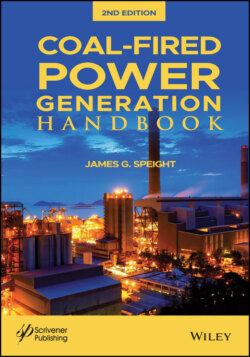Читать книгу Coal-Fired Power Generation Handbook - James Speight G., James G. Speight - Страница 72
3.5.2.5 Other Processes
ОглавлениеWashability is a concept that exploits the differences that exist between the specific gravity of different coals and the associated minerals as a basis for predicting the yields and qualities of the products obtained for any given partition density (Mazumdar et al., 1992; Ryan, 1992). Washability data are always reported in terms of mean specific gravities of particles and those of the liquids used to effect separation. Some degree of predictability during washing operations has become available (Vassallo et al., 1990) which affords a degree of luxury in the determination of recovery and overall behavior of the coal.
Separation of coal and mineral matter can also be achieved by exploiting differences in the surface properties. Froth flotation and oil agglomeration methods (Mehrotra et al., 1983; Schlesinger and Muter, 1989; Couch, 1991; Carbini et al., 1992) are examples of how such separations can be achieved and although differences exist in the surface properties of the coal components.
In coal cleaning by cyclone (Figure 3.4), raw coal and fluid enter tangentially close to the top of the cylindrical section, forming a powerful vertical flow (Meyers, 1981; Couch, 1991). The separation of the impurity from the coal occurs due to a buoyancy effect which arises because of the difference between the mass of any particle and mass of an equivalent volume of displaced fluid. When the fluid is water, this factor is equivalent to the specific gravity. The densest particles therefore move to the wall and downward, and exit with the cyclone underflow. Conditions can be adjusted so that less dense particles remain suspended in the vertical flow and exit from the top of the cyclone. This density separation can be controlled with great precision.
Figure 3.4 Cyclone separation (Speight, 2013).
In practice, a material such as magnetite is reduced to fine sizes, usually in ball mills. The viscosity of the suspension increases with increasing fineness of particle size and particle concentration. The settling rates may be reduced and the stability of the suspension improved by the presence of clays and it may be necessary to recondition the suspension by bleeding off part of the circulating volume and recovering the magnetite in magnetic drums and rejecting the clays. Indeed, there is cause for optimism that magnetic methods of coal cleaning (pyrite removal) will be successful and be applicable as a complement to other methods (Kester et al., 1967; Ergun and Bean, 1968; Trindade et al., 1974; Oder, 1978, 1984, 1987).
Various polymeric flocculants exhibit some degree of selectivity for coal against mineral matter and include chemicals such as partially hydrolyzed polyacrylamide, nonionic polyacrylamide, polystyrene sulfonate, and polyacrylamide containing chelating and complexing groups. In some cases, selective flocculation processes suffer from relatively low selectivity. Thus, selective flocculation processes are usually run in multiple stages to remove the entrained ash-forming minerals.
Traditionally, precombustion cleaning has been concentrated on two major categories of cleaning technology: physical cleaning and chemical cleaning (Wheelock, 1977). A new category of coal cleaning, biological cleaning, has recently attracted much interest as advances have been made in microbial and enzymatic techniques for liberating sulfur and ash from coal (Dugan et al., 1989; Beier, 1990; Couch, 1987, 1991).
Microbes are effective in converting organic sulfur compounds such as thiophene derivatives and dibenzothiophene derivatives. Organic sulfur removal is in the neighborhood of 25% (there are claims of higher removal of sulfur) and the combined use of microbes, either simultaneously or sequentially, could potentially improve organic sulfur rejection. The limiting factors appear to be those of accessibility and residence time. Therefore, finer size coal should be used not only to improve accessibility of microbes to coal particle surfaces but also to reduce the overall retention time in the bioreactor.
